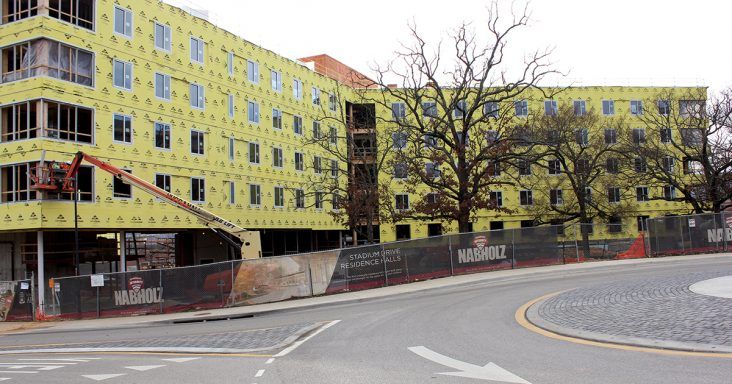University of Arkansas residence hall to open on time, on budget
by March 13, 2019 3:49 pm 2,631 views

Construction on the $79 million Stadium Drive Residence Halls at the University of Arkansas is expected to be completed this summer. Nabholz is the general contractor.
The nearly $79 million Stadium Drive Residence Halls under construction east of Bud Walton Arena are on budget and will open before the move-in period starts Aug. 17, said Christopher Spencer, assistant director for marketing and strategic communications for University Housing at the University of Arkansas.
The 202,027-square-foot residence halls at Stadium and Leroy Pond drives will have 708 beds, and after the closing of Buchanan-Droke and Gladson-Ripley residence halls, total residence hall capacity on campus will be 6,238 beds this fall, Spencer said. Existing capacity is 5,730 beds.
“We’ve been at 100% [capacity] or slightly over for several years in a row now,” Spencer said. “There is a lot of interest in the new hall because of its unique focus on creativity and innovation labs and programs for students. Our new arts-based living learning communities at the hall are drawing early interest and excitement. We hope to open at capacity again this year.”
Asked when the next residence hall project is planned to start, Spencer said there are no timelines for expansion after the Stadium Drive Residence Halls open.
Nabholz in Rogers is the general contractor, and designers are Modus Studio of Fayetteville and Leers Weinzapfel Associates of Boston and Mackey Mitchell Architects of St. Louis.
This is the first large-scale mass timber residence hall project in the United States, and in a recent webinar, Ashley Rao of Leers Weinzapfel Associates, said constructing the structure with cross-laminated timber (CLT) and glulam beams and columns cost about 3.5% more than if steel were used in their place. University officials chose to use CLT because it comes from “sustainably sourced trees” and is “less environmentally impactful than traditional materials like steel and concrete,” Spencer said. Also, timber is a large industry in Arkansas, and the hope is the project would serve as a “showcase for what timber products could be used for in the state.”
UA enrollment has risen 44.7% to 27,778 in 2018, from 19,194 in 2008.
